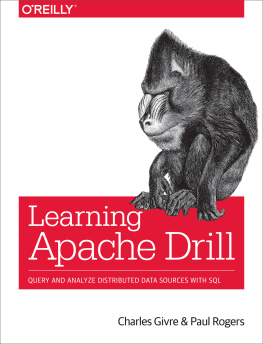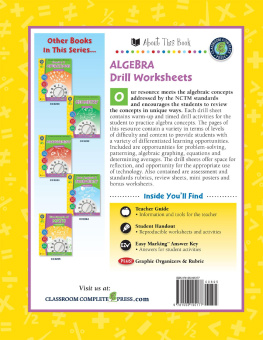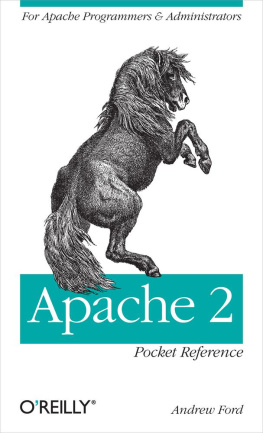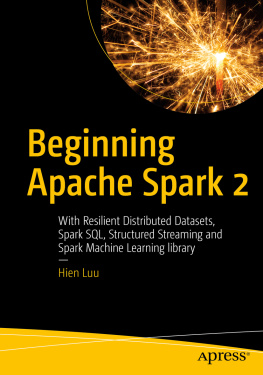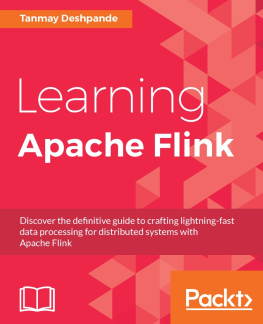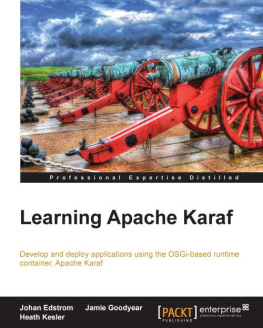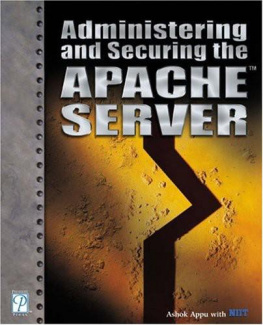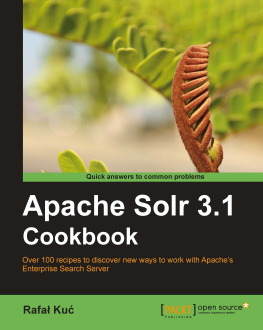Charles Givre - Learning Apache Drill
Here you can read online Charles Givre - Learning Apache Drill full text of the book (entire story) in english for free. Download pdf and epub, get meaning, cover and reviews about this ebook. year: 2018, publisher: OReilly Media, Inc., genre: Computer. Description of the work, (preface) as well as reviews are available. Best literature library LitArk.com created for fans of good reading and offers a wide selection of genres:
Romance novel
Science fiction
Adventure
Detective
Science
History
Home and family
Prose
Art
Politics
Computer
Non-fiction
Religion
Business
Children
Humor
Choose a favorite category and find really read worthwhile books. Enjoy immersion in the world of imagination, feel the emotions of the characters or learn something new for yourself, make an fascinating discovery.
- Book:Learning Apache Drill
- Author:
- Publisher:OReilly Media, Inc.
- Genre:
- Year:2018
- Rating:4 / 5
- Favourites:Add to favourites
- Your mark:
- 80
- 1
- 2
- 3
- 4
- 5
Learning Apache Drill: summary, description and annotation
We offer to read an annotation, description, summary or preface (depends on what the author of the book "Learning Apache Drill" wrote himself). If you haven't found the necessary information about the book — write in the comments, we will try to find it.
Learning Apache Drill — read online for free the complete book (whole text) full work
Below is the text of the book, divided by pages. System saving the place of the last page read, allows you to conveniently read the book "Learning Apache Drill" online for free, without having to search again every time where you left off. Put a bookmark, and you can go to the page where you finished reading at any time.
Font size:
Interval:
Bookmark:
by Charles Givre and Paul Rogers
Copyright 2019 Charles Givre and Paul Rogers. All rights reserved.
Printed in the United States of America.
Published by OReilly Media, Inc. , 1005 Gravenstein Highway North, Sebastopol, CA 95472.
OReilly books may be purchased for educational, business, or sales promotional use. Online editions are also available for most titles (http://oreilly.com/safari). For more information, contact our corporate/institutional sales department: 800-998-9938 or corporate@oreilly.com .
- Acquisitions Editor: Rachel Roumeliotis
- Development Editor: Jeff Bleiel
- Production Editor: Melanie Yarbrough
- Copyeditor: Octal Publishing, LLC
- Proofreader: Rachel Head
- Indexer: Ellen Troutman-Zaig
- Interior Designer: David Futato
- Cover Designer: Karen Montgomery
- Illustrator: Rebecca Demarest
- October 2018: First Edition
- 2018-10-29: First Release
See http://oreilly.com/catalog/errata.csp?isbn=9781492032793 for release details.
The OReilly logo is a registered trademark of OReilly Media, Inc. Learning Apache Drill, the cover image, and related trade dress are trademarks of OReilly Media, Inc.
The views expressed in this work are those of the authors, and do not represent the publishers views. While the publisher and the authors have used good faith efforts to ensure that the information and instructions contained in this work are accurate, the publisher and the authors disclaim all responsibility for errors or omissions, including without limitation responsibility for damages resulting from the use of or reliance on this work. Use of the information and instructions contained in this work is at your own risk. If any code samples or other technology this work contains or describes is subject to open source licenses or the intellectual property rights of others, it is your responsibility to ensure that your use thereof complies with such licenses and/or rights.
978-1-492-03279-3
[LSI]
The ability to analyze massive amounts of data is perhaps one of the most important developments of the 21st century. However, until recently, the tooling to analyze large datasets was exceedingly complex or expensive (or both). Apache Drill has the potential to change all that.
Apache Drill opens up incredible new possibilities for analyzing data because Drill enables you to query a variety of data sources using a standard language.
We envisioned this book for three groups of people: analysts or others who will be using Drill to query data, systems administrators who will be deploying and maintaining Drill in production environments, and developers who will be writing code to extend the functionality of Drill.
Three years ago, Charles was introduced to Drill at the Strata Conference in San Jose, CA, and it sparked a realization that Drill could fundamentally change the way data is analyzed. After a few conversations with MapR chief scientist Ted Dunning, Charles realized that Drill had enormous unrealized potential for use with security-related datasets. However, at the time many of Drills capabilities were undocumented, and the availability of information about how to develop for Drill ranged from limited to nonexistent. Charles wanted to extend the capabilities of Drill, but he had no idea where to begin. This book is everything that Charles would have wanted if he were starting his journey with Drill today.
Paul has worked at a number of business intelligence (BI) companies on a range of query and database tools. When he came across Drill, it seemed like the best of many different tools combined into one, while also being both open source and extensible. Paul joined the Drill team and has worked to get the word out about Drills capabilities.
This book shows you how to use Drill to analyze data effectively. The book is not intended to replace Drills documentation, but rather to serve as a guide to getting you on the right path with Drill. It represents the compilation of several years of lessons learned and should go a long way toward explaining what Drill is and how it solves user problems.
We also wrote this book for people who are interested in extending the capabilities of Drill. After you begin experimenting with Drill, you will likely develop ideas about missing functionality. When Charles started with Drill, the lack of documentation in this area was one of his biggest frustrations, and it is the goal of this book to remedy that situation. Chapters cover in depth how to extend Drills functionality in easy-to-understand language.
This book is intended for three rather distinct audiences, each with different skill sets. Heres how we address these audiences:
- Chapters are a general introduction to Drill. They will give you a good idea of how to get up and running.
- Chapters , all of the chapters in this section require an understanding of SQL.
- Chapters discuss how to extend the functionality of Drill. These chapters require an understanding of Java development to get the most out of them.
- discusses the intricacies of installing and configuring Drill in a production environment. If you are a system administrator, you will want to read this chapter.
- covers many different and diverse use cases for Drill. Regardless of your role, you will want to read this chapter to really understand the power of Drill.
All the code and data files referenced in the book are available at the following repository on GitHub. Please use the Issues tab in GitHub to report any errata in the code.
Drill has comprehensive documentation as well.
The following typographical conventions are used in this book:
ItalicIndicates new terms, URLs, email addresses, filenames, and file extensions.
Constant widthUsed for program listings, as well as within paragraphs to refer to program elements such as variable or function names, databases, data types, environment variables, statements, and keywords.
Constant width boldShows commands or other text that should be typed literally by the user.
Constant width italicShows text that should be replaced with user-supplied values or by values determined by context.
This element signifies a tip or suggestion.
This element signifies a general note.
This element indicates a warning or caution.
Supplemental material (code examples, exercises, etc.) is available for download at https://github.com/cgivre/drillbook.
This book is here to help you get your job done. In general, if example code is offered with this book, you may use it in your programs and documentation. You do not need to contact us for permission unless youre reproducing a significant portion of the code. For example, writing a program that uses several chunks of code from this book does not require permission. Selling or distributing a CD-ROM of examples from OReilly books does require permission. Answering a question by citing this book and quoting example code does not require permission. Incorporating a significant amount of example code from this book into your products documentation does require permission.
Font size:
Interval:
Bookmark:
Similar books «Learning Apache Drill»
Look at similar books to Learning Apache Drill. We have selected literature similar in name and meaning in the hope of providing readers with more options to find new, interesting, not yet read works.
Discussion, reviews of the book Learning Apache Drill and just readers' own opinions. Leave your comments, write what you think about the work, its meaning or the main characters. Specify what exactly you liked and what you didn't like, and why you think so.

